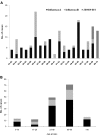Differences in clinical outcomes after 2009 influenza A/H1N1 and seasonal influenza among hematopoietic cell transplant recipients
- PMID: 21372154
- PMCID: PMC3109531
- DOI: 10.1182/blood-2010-11-319186
Differences in clinical outcomes after 2009 influenza A/H1N1 and seasonal influenza among hematopoietic cell transplant recipients
Abstract
It is not known whether pandemic 2009 influenza A/H1N1 (2009 H1N1) leads to more serious disease than seasonal influenza in hematopoietic cell transplant (HCT) recipients. In a retrospective study in HCT recipients with virologically proven influenza virus infection, a total of 161 HCT recipients (18 2009 H1N1, 103 seasonal influenza A, and 40 seasonal influenza B) were analyzed. In multivariable analyses, more patients with 2009 H1N1 had lower respiratory tract disease (LRD), hypoxemia, and prolonged viral shedding compared with seasonal influenza A. Seasonal influenza A and B outcomes were similar. There was no difference in overall and influenza-associated mortality among influenza virus types. Both early and delayed administration of antiviral therapy was shown to be beneficial in terms of decreased rates of development of LRD, although earlier intervention appeared to be more effective. Profound lymphopenia and lack of early antiviral therapy were associated significantly with LRD, hypoxemia, and death. High-dose corticosteroid treatment (≥ 1 mg/kg) given at the time of influenza diagnosis was associated with a reduced risk for mechanical ventilation. Thus, our data suggest that infection with 2009 influenza A/H1N1 resulted in more severe respiratory disease in HCT recipients compared with seasonal influenza.
Figures
Comment in
-
Pandemic influenza: was the concern warranted?Blood. 2011 May 12;117(19):5012-3. doi: 10.1182/blood-2011-03-341511. Blood. 2011. PMID: 21566098 No abstract available.
References
-
- Kim YJ, Boeckh M, Englund JA. Community respiratory virus infections in immunocompromised patients: hematopoietic stem cell and solid organ transplant recipients, and individuals with human immunodeficiency virus infection. Semin Respir Crit Care Med. 2007;28:222–242. - PubMed
-
- Nichols WG, Guthrie KA, Corey L, Boeckh M. Influenza infections after hematopoietic stem cell transplantation: risk factors, mortality, and the effect of antiviral therapy. Clin Infect Dis. 2004;39(9):1300–1306. - PubMed
Publication types
MeSH terms
Substances
Grants and funding
LinkOut - more resources
Full Text Sources
Medical


